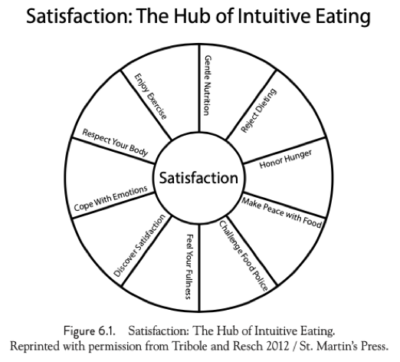What is the Satisfaction Factor?
Posted on September 30, 2021 at 8:47 am | General Wellness | simplynutrition
Written By: Chelsea Ford, University of Alabama Dietetic Intern
As we continue our discussion on Intuitive Eating, it is important to recognize the “Hub of Intuitive Eating”, satisfaction. Satisfaction is discussed in Principle Six: Discover the satisfaction factor. First, what is satisfaction? The Oxford Language defines satisfaction as the “fulfillment of one’s wishes, expectations, or needs, or the pleasure derived from this”.

While practicing intuitive eating, you allow your body’s natural ability to inform you when you are hungry or satisfied. Unlike dieting, intuitive eating focuses on honoring physical hunger as well as mental health. Mental health and emotions are discussed more in Principle 7: Cope with your emotions with kindness.
Diet culture has taken away the pleasure of eating. The eating experience should be pleasurable and satisfying. Think about your typical diet. The first thing that comes to mind is food restrictions of what you can and cannot have. But what happens when you choose to enjoy the foods you have restricted? There are feelings of guilt and lack of control that arise. Then, there is false evidence that leads to the thought that “eating must be constrained.” This type of thinking can cause the diet cycle to start all over. The food you eat should be enjoyable and taste good without those guilty feelings.
As we reject the diet mentality, we are able to tap into pleasure and satisfaction. As we restrict ourselves from foods that satisfy us, it creates a feeling of deprivation and can even lead to overeating. However, when you permit yourself to eat, you may avoid the desire to overeat.
Think of this scenario:
You have a craving for a cookie.
Instead of reaching for the cookie, you opt for celery. To make the celery more filling, you add 2-tablespoons of peanut butter.
After you finish the snack, you are full but, you are not satisfied. You find yourself still wanting the cookie, so you have the cookie as well.
You can find joy in eating again by discovering the satisfaction factor. As you begin to make eating a pleasurable experience, you may find that it takes less food to satisfy you.
How can you increase your satisfaction with food?
- Start small and ask yourself: “What do I really want to eat?”
- This question may be a little more difficult than anticipated. But it is an important question to ask yourself to obtain the greatest satisfaction in your meals. This can be a snack or one meal a day.
- Increase satisfaction by choosing meals with 1 to 2 of the following sensations in mind: sight, smell, touch, sound, mouthfeel, or taste.
- Ask yourself, “do I want something cold or warm? Sweet or savory? Crunchy or soft?”
- Before you eat, observe your meal and your surroundings.
- Eating a meal without considering your environment can diminish the satisfaction of eating. For example, consider the time, distractions, people, clutter, noise, and stressful emotions.
- Reflect on the positives you experienced.
- Think of what could make your home a more pleasant eating environment.
Take Care,
Chelsea



